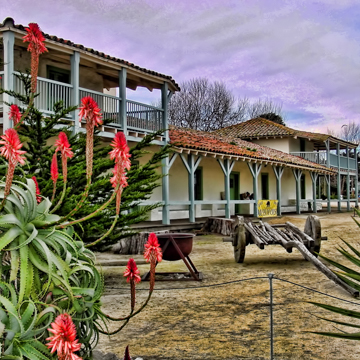The Old Custom House at Monterey Bay is California’s oldest and arguably its most historically significant government building. Between 1814 and 1868, officials working in the Old Custom House regulated commerce and levied import duties on goods entering the port under the flags of Spain, Mexico, and the United States. After 1868, customs operations were terminated in Monterey and transferred to the more commercially vibrant port of San Francisco. The initial structures of the Old Custom House were built in the Spanish Colonial style: single-story adobe buildings with clay tile roofs. However, with additional expansion and construction in the 1840s, the building evolved into a superb exemplar of Monterey Style architecture, which combines Spanish elements with design features of New England colonial architecture, including cantilevered, second-story wooden balconies and gabled roofs.
Beyond its importance as an early administrative office, the Old Custom House serves as a symbol of California’s rise to prominence during an era of dramatic political, economic, and social transformation. Spaniards first sailed to Monterey in the early seventeenth century but it was not until the late eighteenth century that fear of encroachment by Russia and England convinced Spanish officials to actively colonize the area. Workers completed the Monterey presidio in 1771, and the first rooms of the Aduana Maritima de Monterey, the Spanish designation for the custom house, were constructed sometime after 1814, although the exact date remains unclear. After Mexico achieved political independence in 1821, increased commercial activity in the region, particularly in the trade of hides and tallow, necessitated expansion of the custom house. By 1827, the Mexican government had completed construction of a new building, which consisted of two rooms: one large room, used for storage and to house the corporal of the guard; and one smaller room, for the use of other personnel. This structure formed the lower portion of the north wing of the present building.
A third phase of expansion began in 1841, when the Mexican government contracted Thomas O. Larkin to construct additions to the building. By 1846, the Old Custom House had assumed its present form: a one-story, tile-roofed, adobe and rock building, with two-storied, hip-roofed wings with balconies at each end. The same year, Commodore John D. Sloat, commander of the U.S. Pacific Squadron, landed in Monterey, proclaimed California to be part of the United States, and set up headquarters in the building. In 1848, with the signing of the Treaty of Guadalupe Hidalgo, Mexico officially ceded Alta California to the United States. The Old Custom House continued to function under the American flag until 1868, when it was decommissioned by federal order and its offices moved to San Francisco, which had become California’s principal port in the wake of the Gold Rush. During this period no further additions to the building were undertaken.
Between 1868 and the early 1890s, the former custom house served as the residence of the property’s custodian, Thomas G. Lambert. By the turn of the century, however, the building had become dilapidated and was no longer habitable. In 1900, the federal government leased the building to the Native Sons of the Golden West, a fraternal organization dedicated to the preservation of buildings, structures, and sites deemed important to California’s history. A year later, the Native Sons transferred the lease to the State of California. In 1903, the state legislature provided funds to the Native Sons for initial restoration of the building, and in 1917 additional state funds were secured for the project. Between 1903 and 1929, the Native Sons used the Old Custom House as their lodge, while gradually restoring the historic building to its former glory. The building was first opened to the public in 1929, as part of festivities in commemoration of Commodore Sloat’s 1846 landing. On New Year’s Day 1930, control of the Old Custom House was transferred to the California State Park System and the building opened as a public museum. On June 1, 1932, the building was designated the first California Historical Landmark. The State of California acquired the Old Custom House from the federal government in 1938, for the price of $20,000; in 1960 it was named a National Historic Landmark.
Today the Old Custom House is part of the Monterey State Historic Park and is open to the public free of charge.
References
Bancroft, Hubert Howe. The Works of Hubert Howe Bancroft: History of California: Vol. III, 1825-1840. San Francisco: A.L. Bancroft, 1886.
Conway, J. D. Monterey: Presidio, Pueblo, and Port. Charleston, SC: Arcadia, 2003.
Koue, A. Lewis, “Custom House,” Monterey County, California. Historic American Buildings Survey, 1962. Prints and Photographs Division, Library of Congress (HABS No. CAL-133).






